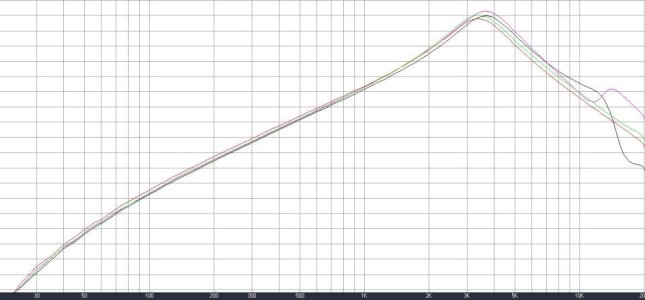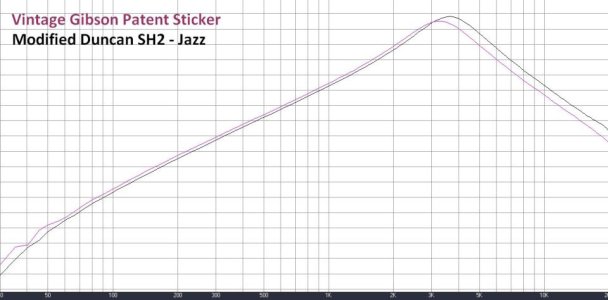freefrog
Well-known member
Well, granted, I’ve slightly modified a SH2 for that. I’ve changed…
-the 4-conductors cable for a braided shielded coaxial one. Got rid of some quirks in the extreme high range, due to capacitive coupling. Who uses a Jazz split or in parallel, anyway?
-the shiny stock A5 bar for a vintage RC one, a bit less gaussed…
-the covered form factor for an uncovered version, “dewaxed” (not a fan of candle wax going out of any hole as soon as a screw pole is turned with a screw driver)…
As the “donor” was some OEM SH2 (black cover, baseplate and slugs, bought half the price of a new one for these precise reasons), I’ve also swapped its BP for a regular NS one and its slugs for vintage correct parts.
Once that done, I had a black neck HB with DCR / inductance of 7.28k / 3.77H, and whose Q factor was exactly the same than with a neck Gibson Patent Sticker T-Top measuring 7.33k / 3.88H...
This modified SH2 has been paired with another Gibson Patent Sticker T-Top from 1968 (7.6k, 4.14H) and it’s a match made in heaven IME/IMHO. YMMV.
If the goal had been to find a substitute for a Pat. Stick. In bridge position, I’d have used another neck SH2 but in its Custom Shop version: they seem to have an higher inductance… My archives ranked them at 4.2H and the last "MJ" SH2N that I’ve measured, a few days ago, was at 4.24H.
FWIW and for those who want something cheaper than a Throbak, BrandonWound or Manlius T-Top replica...
-the 4-conductors cable for a braided shielded coaxial one. Got rid of some quirks in the extreme high range, due to capacitive coupling. Who uses a Jazz split or in parallel, anyway?
-the shiny stock A5 bar for a vintage RC one, a bit less gaussed…
-the covered form factor for an uncovered version, “dewaxed” (not a fan of candle wax going out of any hole as soon as a screw pole is turned with a screw driver)…
As the “donor” was some OEM SH2 (black cover, baseplate and slugs, bought half the price of a new one for these precise reasons), I’ve also swapped its BP for a regular NS one and its slugs for vintage correct parts.
Once that done, I had a black neck HB with DCR / inductance of 7.28k / 3.77H, and whose Q factor was exactly the same than with a neck Gibson Patent Sticker T-Top measuring 7.33k / 3.88H...
This modified SH2 has been paired with another Gibson Patent Sticker T-Top from 1968 (7.6k, 4.14H) and it’s a match made in heaven IME/IMHO. YMMV.
If the goal had been to find a substitute for a Pat. Stick. In bridge position, I’d have used another neck SH2 but in its Custom Shop version: they seem to have an higher inductance… My archives ranked them at 4.2H and the last "MJ" SH2N that I’ve measured, a few days ago, was at 4.24H.
FWIW and for those who want something cheaper than a Throbak, BrandonWound or Manlius T-Top replica...
Last edited:


